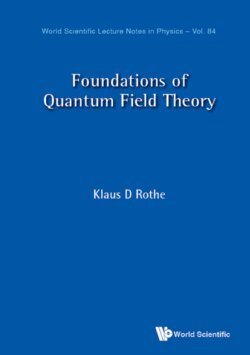Читать книгу Foundations of Quantum Field Theory - Klaus D Rothe - Страница 16
На сайте Литреса книга снята с продажи.
2.5Transformation properties of massive 1-particle states
ОглавлениеIn analogy to the Galilei transformations discussed in Chapter 1, we take U[L()] to be the unitary operator taking the state |s, σ > of a particle of spin s, sz = σ at rest into a 1-particle state of momentum .9
where
with normalization
Note that the spin of a particle at rest is a well defined quantity, whereas for a moving relativistic particle this is not the case. The kinematical factor introduced in (2.39) compensates for the non-covariant normalization of the 1-particle states:
The form of this kinematical factor can be motivated in the following way: The normalization (2.42) of the 1-particle states corresponds to the completeness relation
Now, d3p is not a relativistically invariant integration measure, whereas d3p/ω() is. Indeed, making use of the usual properties of the Dirac delta-function we have
The delta-function insures the proper energy momentum relation for a free particle,
while the theta-function insures that the vector pμ is time-like, that is, the particle has positive energy. Both properties are preserved by Lorentz transformations in . Furthermore, d4p is a Lorentz-invariant measure since
and
We thus conclude that
This explains roughly the origin of the kinematical factor in (2.39).10 Now let U[Λ] be the unitary operator inducing a Lorentz transformation on the 1-particle state |, s, σ′. Using the group property of Lorentz transformations , we have
It is easy to see that the matrix
is not equal to one unless Λ represents a pure boost colinear with . In general RW represents a pure rotation — the so-called Wigner rotation — in the rest frame of the particle. We may thus make use of the completeness relation
valid in the rest frame of the particle in order to write (2.44) in the form
where we have made the identification
with D(s)[RW] a (2s + 1)-dimensional irreducible representation of the rotation group. We thus finally have
At this point we can now firmly establish the correctness of our choice of normalization factor in (2.46). To this end we start from the completeness relation
and multiply this relation from the left with U[Λ], and from the right with U−1[Λ]:
We now make use of (2.46) in order to rewrite this relation as
Making use of the unitarity of the matrix representation of the rotation group, we have
Hence we obtain from above
Recalling the transformation property of the integration measure, Eq. (2.43), the above expression reduces to
showing that our choice of normalization is consistent with the Lorentz covariance of the completeness relation.
